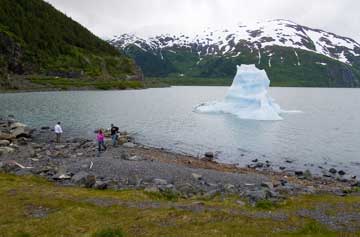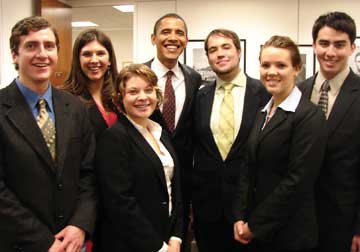|
FEATURE
Strange Bedfellows? Evangelicals and Scientists Join Forces on Climate
Nicole Branan
| Alaska’s Portage Glacier, about an hour outside of Anchorage, was one stop for the coalition of evangelicals and scientists visiting Alaska to see the effects of climate change firsthand. The valley glacier has retreated extensively in recent decades, leaving a growing lake and impressive icebergs as it recedes. Compare the photo taken in 1980, below, to the one above taken last year. |
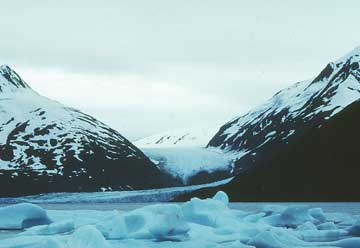 Copyright Carol and Steve Baskauf |
Global warming is melting permafrost around the world, but earlier this year rising temperatures also led to the thawing of the notoriously frosty relations between scientists and evangelical Christians, triggering climate change of the political kind. Alarmed by the potential impact on society that climate change poses, leaders of both camps laid down their arms over how we arrived on Earth and joined forces, issuing an “Urgent Call to Action” to address global environmental issues. “Business as usual cannot continue yet one more day” their statement said, urging fundamental changes in values, lifestyles and public policies to address worsening environmental problems “before it is too late.”
The unprecedented cooperation between the two otherwise often diametrically opposed groups could be an important step toward the promotion of policy changes, says Roger Pielke Jr., a political scientist at the Center for Science and Technology Policy Research in Colorado. “The joining of forces of people who otherwise disagree on important issues is exactly how political change happens,” he says. The climate issue has been marked by strong partisan differences in the United States, he says, adding that the nature of the debate has reinforced these differences because it has focused on trying to get people to think alike. “But as [American journalist] Walter Lippmann once said, the challenge of politics is to get people who think differently to act alike.”
The seeds for the unlikely marriage were sown at a lunch between two close friends almost two years ago, says Eric Chivian, director of the Center for Health and the Global Environment at Harvard Medical School and a signatory on the call to action. Over soup and salad, he and Rev. Richard Cizik, vice president for governmental affairs of the National Association for Evangelicals, talked about what they believed to be a “dangerous degree of distrust between many scientists and evangelicals.” Both agreed that it was critically important that the two powerful communities work together to make progress in addressing issues such as global warming and habitat destruction. “Yet they were hardly speaking to one another,” Chivian says. Determined to break the deadlock, the duo arranged a three-day private retreat in December 2006, inviting some 30 scientists and evangelicals. The team says it selected participants based on demonstrated “dedication to educating others” as well as “open-mindedness” and willingness to establish a dialogue.
At the retreat, “I expected that some of my evangelical colleagues would see me as a latte-sipping, Prius-driving, New-York-Times-reading, endive-munching person and I might see them as Hummer-driving, Bible-thumping, fire-breathing pastors,” Chivian says. Instead, he says, the attendees discovered that they “really liked each other” and were there because they shared a deep reverence for life on Earth and a profound concern about what human activity was doing to it. “Most of us were not just surprised but astonished by the depth of our shared moral commitment,” says David Gushee, an ordained minister, professor of moral philosophy at Union University in Tennessee and a signatory on the call to action. Both sides agreed that “reckless human activity has imperiled the Earth,” Chivian says, and the challenges facing the entire global community made their differences in beliefs look trifling. “There is no such thing as a Republican or Democrat, a liberal or conservative, a religious or secular environment. We all breathe the same air and drink the same water,” he says.
Following the December retreat, on January 17, the group, spearheaded by leaders of Harvard University’s Center for Health and the Global Environment and the National Association of Evangelicals, sent their statement to President Bush, congressional leaders and national evangelical and scientific organizations. Twenty-eight coalition members, including university scientists, conservation organization directors, evangelical organization leaders and pastors, signed the statement.
| Campus leaders from Trinity University and from Restoring Eden, a faith-based grassroots movement for environmental conservation, meet with Sen. Barack Obama to share their concerns on climate change. |
The coming together of these groups indicates that action is on the horizon, even though members of the new coalition have yet to work out the details of how to achieve their goals. The group’s main objective is to advance dialogues and influence policy on a variety of climate change issues, such as reducing greenhouse gas emissions. “We must stop the growth of carbon dioxide emissions now and reduce emissions in the next few decades, and by perhaps 80 percent before the end of the century,” says signatory James Hansen, director of NASA’s Goddard Institute for Space Studies in New York. “Other air pollutants must also be reduced, and there will be many benefits of reducing emissions, especially to energy independence and national security.”
Signatory Joel Hunter, senior pastor of Northland Church in Orlando, Fla., expects the merging of scientists’ and evangelicals’ efforts and resources to open up unique opportunities. “[Scientists] have the facts we need to present to our congregations [and] we have the numbers of activists that will work through churches, government and the business community to make a significant impact,” he says. And there can be little doubt that one of the strengths of the National Association of Evangelicals lies in its numbers. Comprising approximately 45,000 churches, the umbrella organization represents more than 30 million Americans. Evangelical and scientific communities combined have the capacity to change national dialogue about the environment, Gushee says.
After issuing their call to action in January, the group formed a steering committee, made up of seven scientists and seven evangelical leaders, to plan the group’s further steps. One of the first joint activities was a trip to Alaska in August where scientists and evangelicals examined firsthand the effects of climate change on people and ecosystems, an experience that the attending evangelicals say they plan to include in their sermons. The trip also provided an opportunity for the two sides to get to know each other in a personal setting, and for scientists to learn from pastors how to communicate the environmental changes they saw to a non-scientific audience. While in Alaska, the team visited Portage Glacier, a glacier outside of Anchorage that has begun to retreat from the lake it created, before they headed to the Kenai Peninsula to see where exploding populations of Spruce bark beetles have killed more than 3 million acres of spruce forests. According to the United States Global Change Research Program, the outbreaks are most likely caused by warming temperatures in the region. Last on the agenda was a visit to a small Inuit village in the Bering Strait whose inhabitants may be forced to relocate to mainland Alaska after 14 houses have fallen into the sea due to increased erosion (see story, this issue). Village elders told the group about the dramatic changes they have witnessed, such as the thawing of permafrost along the coast which allows higher storm surges to reach the shore.
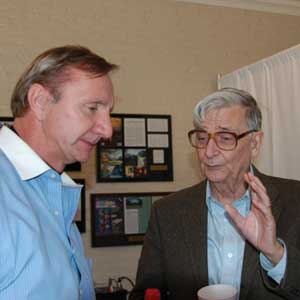 |
| Eric Chivian (below), director of the Center for Health and the Global Environment at Harvard Medical School, and Rev. Richard Cizik (above, left), vice president for governmental affairs of the National Association for Evangelicals, brought together two seemingly disparate sides — scientists and evangelical Christians — in a cooperative effort to influence policymakers to take steps to mitigate climate change. Edward O. Wilson, an evolutionary biologist at Harvard University pictured with Cizik, attended the evangelical-environmental conference in December. |
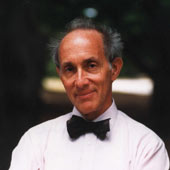 |
Both images above are from the Center for
Health
and the Global Environment at Harvard Medical School |
The group will hold a steering committee meeting this fall to plan further steps, which are likely to include a speaking tour for scientists and evangelicals to engage the public and develop teaching guides on “Creation Care” for Sunday School classes.
The new-found cooperation between scientists and evangelicals calls into question whether the two were ever really divided over environmental issues. “Significant misperceptions about the perspectives of the other community” seemed to have prevented any earlier collaborations, says Jim McCarthy, a biological oceanographer at Harvard University in Massachusetts. Even though their individual motivations for protecting the planet differ — evangelicals see it as their moral responsibility to God, Cizik says, while most scientists feel responsibility toward Earth itself, McCarthy adds — their resulting views are the same. And because a healthy environment provides not only economic opportunity and environmental security, but also spiritual fulfillment, it is only appropriate that the issue is addressed jointly by science and religion, says signatory Edward O. Wilson, an evolutionary biologist also at Harvard University.
Indeed, economics is the base of much of the discussion in the coalition, with both scientists and evangelicals alike suggesting that a healthier planet will help the world’s poor to become less impoverished through improved food, water and sanitation situations, for example. The coalition cites concern for the poorest of the poor as one of their main motivations for the mitigation of any future warming. They predict that future global warming will cause food and water sources to dwindle even further, leading to more suffering. “Protecting the environment is another way of protecting life … specifically for the poor, who are least able to be insulated from environmental deterioration,” Hunter says.
This very issue, however, has exposed deep rifts within the evangelical community. A few days after the call to action was issued, Interfaith Stewardship Alliance, a coalition of religious leaders, theologians and scientists who do not think global warming is caused primarily by humans, sent a statement to President Bush distancing itself from the call to action statement and denying any broad consensus of scientists and evangelicals.
“We do not believe we are on the verge of making the Earth a different kind of planet,” wrote E. Calvin Beisner, spokesman of the group, which has since changed its name to Cornwall Alliance for the Stewardship of Creation. Scientific evidence supports the view that climate change in the past 30 to 150 years has been “largely natural in origin” and is “unlikely to be catastrophic to humanity or the rest of the biosphere,” the group states. Moreover, the cost of achieving even tiny mitigation of future temperatures through any policy of greenhouse gas emissions reductions would far outweigh the benefits, they say. By restricting the supply and raising the price of energy — for example by limiting the use of fossil fuels — any efforts to mitigate future global warming would slow economic development for the world’s poor, Beisner wrote. “What these poorest of the world’s poor need far more than a reduction of global average temperature by a fraction of a degree 50 years from now is the economic development that will allow them to electrify their homes … treat their sewage; and purify their drinking water.”
The Urgent Call to Action was not the first time that evangelicals expressed concern about the environment. A year prior, in January 2006, a group of 86 senior leaders launched the Evangelical Climate Initiative, saying that their commitment to Jesus Christ and his commands to be proper stewards of his creation compelled them to take action to stop global warming.
Scientists, meanwhile, have long warned of consequences if climate change continues unabated. The fact that both groups have now joined forces shows that a broad coalition on the climate issue is possible, Pielke says. “And the sooner the debate focuses on actions that make sense, rather than what everyone does or does not believe, the better.”
Vatican goes greenAmerican evangelicals are not the only Christians aligning their faith with a commitment to the planet (see main story). Pope Benedict XVI has stepped up the Vatican’s commitment to saving the planet over the last year, culminating in the announcement in July that Vatican City will become the world’s first carbon neutral sovereign state. In addition to planting trees in Hungary to offset the carbon-dioxide emissions and energy use of Vatican City, next year, the Holy See will cover the rooftop of the papal audience hall adjacent to St. Peter’s Basilica with solar panels, so that the entire building can be heated, cooled and lit with solar power. Engineer Pier Carlo Cuscianna, head of the Vatican’s department of technical services, told Catholic News Service (CNS) May 25 that there are plenty of other sites throughout Vatican City where solar panels could also be installed. Cuscianna said that safeguarding the environment is one of the most important challenges of today, as both Popes Benedict XVI and John Paul II advocated. These are not the first environmentally friendly steps the Vatican has taken. In 1999, the Vatican replaced the entire lighting system of St. Peter’s Basilica with energy-saving light bulbs, cutting the basilica’s energy consumption by 40 percent, according to the CNS article. In 2000, the Vatican opened an electric vehicle charging station, so electric wheelchairs, scooters and cars could recharge. The Vatican is also considering recycling, composting and waste reduction programs, according to CNS. In April, the Vatican hosted a conference on climate change, bringing together scientists on both sides of the climate debate (human- versus non-human-induced climate change) and theologians to discuss how to responsibly develop and care for the planet. The world’s largest church recognizes that climate change is occurring, though it does not speak to how or why, Monsignor James Reinert of the Pontifical Council for Justice and Peace told USA Today on July 25. Like the current efforts by American evangelicals, however, the church is not in favor of any sort of taxes or restrictions that would burden poor, developing countries. The church seeks “integral human development,” which balances the quality of human life with the environment, Paolo Conversi of Rome’s Pontifical Gregorian University said in the same article. |
Links:
"Alaska melting into the sea," Geotimes, September 2007
adriftphotography.com
Restoring Eden

 Subscribe
Subscribe

